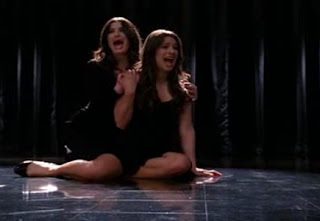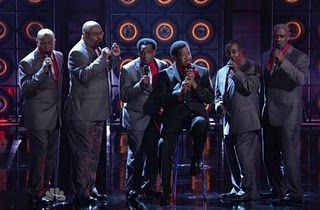10 Musical People and Things that Had an Awesome 2010!
In no Particular Order:
Those Rappers You Almost Forgot About
Hey, who's that guy with Andre 3000??
In 2010, members of former hip hop super groups took a huge step into the limelight, led by Will. I. Am. of the Black Eyed Peas and Cee Lo Green of Gnarls Barkley fame.
Will. I. Am seemed to be featured in everyone's music videos and singles from Rhianna to Usher, and he played an integral part in the culmination of artists for the Haiti Relief version of "We Are the World". He has stepped into the role of producer and talent scout while continuing to produce chart topping albums with the Black Eyed Peas, performing for President Obama, collaborating with Sheryl Crow and Herbie Hancock, and composing for movies (see "Thriller").
Cee Lo Green meanwhile, managed to exceed his post-Gnarls Barkley career with one of the catchiest hooks of 2010 and a mean, soul-infused hip hop album, "Fuck You" from Lady Killer.
And let's not forget to mention Big Boi, who with 2010's release Sir Luscious Leftfoot: The Son of Chico Dusty, has reminded us that it wasn't just Andre 3000 that made OutKast so awesome. Big Boi has certainly been a busy boi, not only releasing one of the best hip hop albums of the year, but also collaborating with one of the years best concept albums - Janelle Monae's ArchAndroid.
Add in the veteran Mos Def's venture back from the silver screen to rapping with 2010's The Ecstatic, and you have a pretty good year for all those rapper you almost forgot about.
A Capella Pop
Whether you see it as a musical novelty act or serious music, pop-capella has made a huge comeback in 2010.
It's really not all painful like these ladies think it is, we promise.
With the popularization of the genre through Glee, a cappella groups have spawned at an impressive rate in 2010. NBC's mini-series the Sing-Off has cashed in on the sudden surge, and it has pushed several "unknowns" into the American limelight, like last year's winner Nota, who released their debut CD this year, as well as brought back forgotten legends Jerry Lawson and The Talk of the Town.
These men will make you forget what an instrument even looks like.
Trent Reznor of Nine Inch Nails fame chose the all girls a capella group Scala and the Kolacny Brothers to score parts of The Social Network film, and Ben Folds released an album of several of his hits covered by various collegiate a cappella groups this year.
Sufjan Stevens
After scaring the minimalist crap out of his fans by mentioning his thoughts on retiring from the music scene, Sufjan came back in a BIG way in 2010, releasing a full length EP, All Delighted People, and a chart topping concept album, The Age of Adz, within months of each other.
Both recordings were well acclaimed, and Adz is widely being considered as one of the best concept albums of the year. Stevens has been touring up a storm this year, and he seems to have finally found a balance between the soft spoken introspection of his popular songs ("Casimir Pulaski Day", "Chicago", "Alone With You") and the intellectually experimental samples from his less popular albums (A Sun Came!, BQRE, etc.).
His latest successes almost make you forget about that jaded angst that he hasn't made an album for your state yet.
The Music Video
The renaissance of music videos as a medium in and of themselves - rather than compliments to the music - began in 2009, but really picked up speed this year.
Lady Gaga, with some help from Beyonce, continued to re-popularize the extended music video founded by Michael Jackson's "Thriller" in 2010 - but she wasn't alone.
Musicians began to employ real actors for their music videos more regularly in 2010: Eminem and Rhianna employed Lost and Lord of the Rings star Dominic Monaghan and Megan Fox, while Vampire Weekend's video for "Giving Up the Gun" starred everyone from Jason Gyllenhaal and Jenny Murray to Lil' John and Joe Jonas.
The story telling didn't stop there - Cee Lo Green depicted the lifelong storyline of "Fuck You", while Jason Ritter chose claymation to act out "The Curse".
Music video veterans OK Go! continued their domination of the field, releasing two of the best music videos from 2010 - whether they were playing with dogs ("White Knuckles"), marching bands and swamp monsters ("This Too Shall Pass"), or experimenting with a wildly awesome Rube Goldberg machine ("This Too Shall Pass", second video). Following in suit in perhaps the only music video of 2010 to hold a candle to OK Go's creativity, Holderdao's stop-motion human 8-bit video for "Americanarama" upheld the true youtube tradition and was shot in only one take.
The Roots
Somehow still better known as "Jimmy Fallon's House Band", The Roots took 2010 to cement themselves as the most versatile band of the past decade with an original - their best studio album to date, How I Got Over, as well as another collaboration album - this time with John Legend.
The Roots changed their tone for How I Got Over, a self-described "positive album," focusing on learning from the Bush administration and the hope to come under Barack Obama. The album, although covering some songs and with various guests including Twalib Kweli and Beanie Sigel, is mainly composed of original tracks by the group. Wake Up!, their collaboration with John Legend, consists of all cover songs of 1960's and 70's protest songs, with a few scattered Legend originals thrown into the mix.
Auto Tune
They did it to Akon. They did it to T-Pain. They did it to GaGa. They did it to the news. They even did it to the Bedroom Intruder and the Double Rainbow guys.
Every decade or so, some new technological advance runs rampant for no to little good reason in pop music - from the whammy bar of the late 50's to the synth-happy 80's. In the 2000's, that technology was as catchy and annoying as ever - Auto Tune.
We've all heard it at some point this year in either two forms - that odd, robotic Peter Frampton sounding wobble or a noticably ultra-human straight tone (think any Glee solo). Is it a cool affect? Definitely. Has it gotten a bit out of control in 2010? Absolutely. Do we still love it? Shamefully, yes.
Mumford and Sons
There wasn't a single import in 2010 who came crashing into America quite as instantaneously than these Brits in 2010.
Their debut record, Sigh No More, has continued to maintain its place in the top 10 album downloads of the major digital music sites, and is getting some serious recognition - going double platinum in Australia and platinum in the groups home country. The single from the record, "Little Lion Man", is nominated for Britain's Mercury Prize this year as well.
The group has been touring throughout the British Isles, as well as taking their stylistic smorgasbord of big band, Brit-folk, and gospel across the pond during Bonaroo. Contemporaries Old Crow Medicine Show love the group, saying, "The Mumford Boys...songs worth remembering, driving long distances under the influence of, loving someone under the spell of; good songs that last long after the turntable stops".
When the living legends of your genre are publicly gushing over you, you've had a pretty decent year.
DJ's
Earlier in the decade, P2P file sharing and sampling put earnest DJ's in the musical and political spotlight, climaxing with Dangermouse's Grey Album. After the courts finally subdued the issue a bit midway through the 2000's, the public eye shifted back to the pop main stage. Which provided plenty of cover for a group of experts to bring back sampling, mixing and collaborating with vengence.
2010 saw the emergence of Canadian DJ extraordinaire Deadmau5. Within the past year, the giant mouse-headed jockey released his third studio album, 4X4=12, performed at the Olympics and Video Music Awards, won the Juno Award for Dance Recording of the Year for For a Lack of a Better Name, and was named best electro house artist and best progressive house artist by Beatport. Just don't tell him he's a DJ.
Dangermouse continued his collaboration path off of the success of his Broken Bells collab with The Shins' James Mercer by working with indie darlings Sparklehorse on the double disc doozie Dark Night of the Soul.
RJD2 not only cemented his place in the scene thanks to the popularization of AMC's Mad Men, but also put out two albums, Deadringer and Inversions of the Colussus.
Girl Talk also dropped a new album this year, the 73 minute long groovable sampler All Day.
And let's not forget to mention the newest Harmonix gaming spawn, DJ Hero, or the various youtube DJ's (the A.Q.'s favorite being DJ Calmucho). Add in the gentle return of sampling into the permisable realm (We're looking at you, Pomplamoose!), and this was a sneakily good year for the DJ scene.
David Foster
Sure, there really isn't a year for David Foster that isn't good - over the past four decades, the songwriting powerhouse has scored 15 Grammies, 7 Juno Awards, an Emmy, and 3 Oscar nods, not to mention the fact that he is the man behind some of the centuries greatest chart toppers.
But 2010 was an especially good year for Foster. His record label is doing quite well, and is currently promoting Josh Groban's newest release. Foster has found, fostered, promoted, and produced young talent like no other in 2010 - working with (and becoming the Godfather of) both Filippino starlet Charice and 10 year-old opera phenom Jackie Evancho.
Oh yeah, and he also was inducted into the Song Writer's Hall of Fame.
Janelle Monae
Dance moves like the spawn of Michael Jackson and Gumby. Creativity of David Bowie. And a sweet iconic haircut that would make Flock of Seagulls weep in damn pride.
You wish you could pull this off.
Welcome world, to Janelle Monae.
Although she's been around before 2010, the music industry just wasn't ready for Monae until this year, when she broke through with perhaps the greatest album of the year, ArchAndroid, which is already earned a Grammy nod for best contemporary R&B album.
A concept album with a Flight of the Conchords-David Bowie concept (alien robots trying to escape a totalitarian government in order to freely feel and reproduce), ArchAndroid is an eclectic and awe-inspiring cross-genre album that shows Monae's mastery of her art as well as her funky, soulful vocals. The album features the single "Tightrope", featuring Big Boi and some of the most fluid, cool choreography in recent years. But it also features tracks that include a made up language, full orchestras, big band swing, 50's du-wop, and guests ranging from Saul Williams to Of Montreal.
Her live shows are metaphysical experiences in and of themselves - and somehow, it all works seamlessly.
Impressive.













